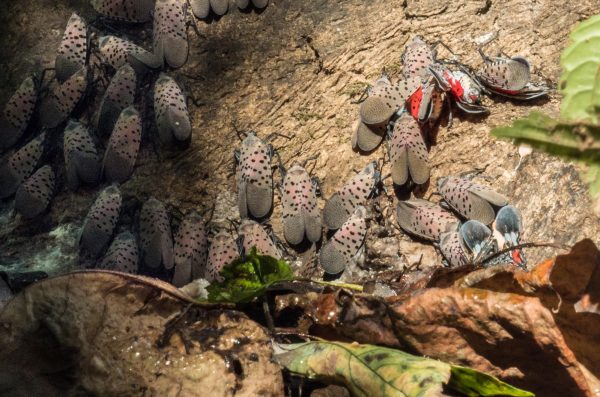In late August, Diana Sette interrupted her usual commute through Cleveland’s University Circle district to tend to an injured squirrel.
The sidequest was not unusual for Sette, a horticultural therapist at University Hospitals Rainbow Babies and Children’s. Whether she is caring for the hospital’s rooftop garden, or bringing plants for a patient to water, nature consumes a great deal of her life.
“We are nature,” Sette said. “The more that we can connect with nature, the more that we can heal parts of ourselves.”
As she helped the squirrel back up on its feet and guided it across the busy streets of east Cleveland, an insect – seemingly out of nowhere – flew into her face. When she looked down and saw its polka dotted wings spread to reveal a bright red undercoat, she stomped on it.
She had just encountered her first spotted lanternfly.
Sette’s decision to kill the insect wasn’t easy, she said. She hesitates to call herself a “diehard stomper,” but she said she had read the news reports about the invasive species’ spread across the Northeast and had listened in on watercooler conversations with her colleagues in the environmental field.
While she admires the spotted lanternfly’s “gorgeous” red coat, she also understands the danger its presence signals.
“I feel like it’s an alarm,” Sette said. “There’s something that nature is communicating to us.”
In September 2014, a Pennsylvania Game Commission wildlife education specialist identified the first spotted lanternfly in the United States while surveying trees in Berks County, Pennsylvania, where he noticed a large number of the insect congregating on the tree-of-heaven, also an invasive species and its preferred host.
Entomologists with the Pennsylvania Department of Agriculture collected more than 100 specimens on the day of that first sighting, according to the department. This was not a one off incident, they concluded, but an all-out infestation.
“We quickly engaged the U.S. Department of Agriculture,” said Shannon Powers, press secretary for the Pennsylvania Department of Agriculture. “Lanternflies are an invasive species – they don’t belong in this environment.”
While the spotted lanternfly itself is harmless to humans, it poses a serious threat to agriculture.
The insect damages the plants it feeds on, causing wilting, oozing sap and death. The spotted lanternfly’s feeding also has a secondary effect — leaving behind a sugary liquid known as honeydew, which promotes the growth of sooty mold. When that mold grows on fruit, it cannot be consumed.
While the spotted lanternfly prefers the tree-of-heaven, which are nearly impossible to eradicate due to its extensive root systems and aggressive tendency to sucker and resprout, they have also shown a strong tendency for grapevines.

“It’s probably the biggest threat to the grape growing industry,” said Jonathan Shields, an agriculture inspection manager who oversees the Ohio Department of Agriculture’s spotted lanternfly program.
Like much of Pennsylvania and the Midwest, Berks County is home to a thriving agriculture industry. In 2017, its 1,809 farms accounted for 7% of the state’s agriculture sales.
In Pennsylvania, the agriculture industry generates $132.5 billion each year and supports more than 593,000 jobs.
Within two weeks, a team of researchers assembled at the site.
Julie Urban, an evolutionary biologist and research associate professor at Penn State University, was among the group of specialists on the ground in Berks County. She has spent her career understanding the spotted lanternfly’s evolutionary history, and she wrote her dissertation on the genetics of the plant hopper, the super family the insect belongs to.
The team pinpointed the source of the infestation to a landscaping company that imported stones. Workers at the facility reported “seeing these little things jumping around,” Urban said, “and they were trying to step on them.” The mysterious insect had troubled the company for at least a year.
In an effort to contain the infestation, Berks County needed to go into quarantine, Powers said. The state restricted the transportation of certain agricultural products without inspection for the spotted lanternfly, and businesses, agencies and organizations now needed a first of its kind spotted lanternfly permit to move regulated articles within or out of the quarantine zone.
“The spotted lanternfly is a really effective hitchhiker,” Shields said.
Named for a fly, the insect looks like a moth but is actually a plant hopper – and it doesn’t like to fly. In a typical invasive species case, this would deter an outbreak.
Not here.
On its own, the spotted lanternfly can only travel a few miles – but it can cling tightly to automobiles traveling at high speeds.
As it adapted to its new habitat, the spotted lanternfly started laying its egg masses on outdoor furniture, vehicles and just about any smooth surface it could get its wings on, Powers said. Its egg masses, which resemble clumps of mud, contain 30-50 eggs.
“It only takes one adult, pregnant lanternfly to start a population,” Powers said.
The quarantine aimed to slow, if not curb, the spread of the spotted lanternfly within Pennsylvania and to other states – like Ohio, which has a $6 billion grape industry.
However, since 2014, Pennsylvania has added 51 counties to the quarantine list, and the spotted lanternfly now inhabits 14 states.
In 2020, the first spotted lanternfly in Ohio was discovered in Jefferson County. The state has since placed eight counties with established populations under quarantine: Cuyahoga, Franklin, Hamilton, Jefferson, Lorain, Lucas, Mahoning and Muskingum counties.
“I think we will see additional spread in Ohio,” Shields said. “What we’re really trying to do is slow that spread down as much as we’re able and allow the science and opportunity to sort of catch up with the invasion.”
Back from Berks County, Urban spends her days doing just that. She leads a multi-institution, regional grant funded by USDA-NIFA exploring novel ways to combat the spotted lanternfly.
The most promising developments, she said, come from classical biological control.
In 2015, researchers traveled to Asia in hopes of finding a natural predator to the spotted lanternfly, Urban said. There, they identified a parasitoid wasp that lays its eggs in the spotted lanternfly’s eggs, which then hatch and eat them from the inside out. They brought those wasps back to the U.S., where they remain in quarantine, to study how they might interact with native species.

After years of genetic analysis and testing its interactions with other insects, they determined it posed too great of a threat to native species in North America.
“They brought back that first wasp in 2015, and it’s still only in quarantine,” Urban said. “It’s only now that it’s gotten to the point where they have enough data to decide not to further pursue it. They’re super cautious.”
However, a second species of wasp, which lays its eggs in spotted lanternfly nymphs and eats it from the inside out, has proved more promising, Urban said. But it may take a matter of years for scientists to determine its role in controlling the spotted lanternfly population.
In her own lab, Urban studies the spotted lanternfly’s genes and the microbes found in sooty mold. If researchers can understand how the spotted lanternfly operates, and just what makes it so dangerous, she said they may unlock new opportunities for control.
“Some of the basic biology work that I’m working on is trying to find an Achilles heel to it,” Urban said. “If we know more, then we can come up with better sustainable management solutions. So, I’m optimistic that the science will find a way and there’s enough of us working on it.”
As the seasons move into fall, a pivotal moment of the spotted lanternfly’s life cycle – and its greatest opportunity for further spread – arrives. In the coming weeks, the insect will start to lay its egg masses, and travelers may unknowingly aid a new infestation, Shields said.
USDA-NIFA and state departments of agriculture have worked to target areas with a high risk for transit, such as interstates and train stations, with insecticidal treatments. But what works for one area does not work for another, such as those with native species susceptible to insecticides.
Since the invasion, researchers have developed spotted lanternfly traps that are now widely available online and in hardware stores. If someone encounters spotted lanternfly eggs, they should take a photo for documentation and destroy it with a stick or scraper.
After Sette shared her first encounter with the spotted lanternfly on Facebook, she said the number of people who shared sightings of the insect throughout Cleveland shocked her. And while she would love to see the “pretty pest” in its natural habitat, she called it a civic duty to take action against its invasion – even if that means killing each one she sees.
Powers, like others experts, expressed empathy for having to squish the spotted lanternfly while stressing the importance of taking action.
“People tend to not care about things until they’re sort of hitting them in the face, which lanternflies literally do,” Powers said.
Alton Northup is a staff reporter. Contact him at [email protected].






















Judy • Nov 8, 2023 at 5:55 am
Great article. Very informative